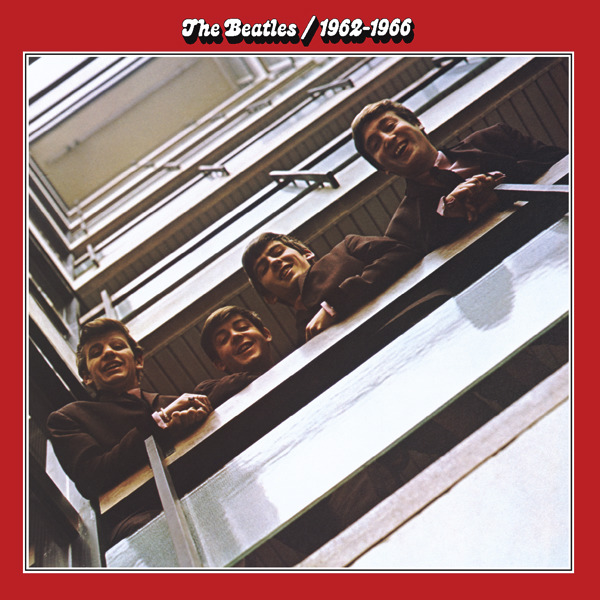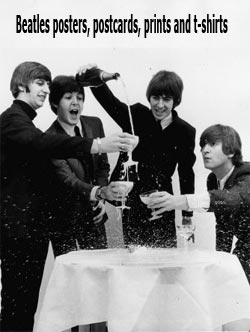 |
| The Beatles 1962-1966 aka "the Red album". |
Apart from those, whatever differences there were between those versions and the ones on the original albums remain. Analog Planet quotes Magee, who said:
"The cutting notes made by Harry Moss were followed to the letter except for overall levels, which were a touch quieter, but cleaner. All analogue too".So, as far as hype goes, AAA is the new DDD these days.*
We presume that it's the original British masters that were used, as you know there were a few differences between the US and the British original releases of these.
"Help!" on the American edition includes the same pseudo-James Bond intro as the mix found on the American Help! soundtrack LP, while the same song on the British edition does not. Also, the British LP uses the stereo "whispering intro" mix of "I Feel Fine", while the US LP uses the mono mix from Beatles '65, which is drenched in additional reverb. Here's a comparison:
US vs UK 1973 Red Album
| Song |
USA
|
UK
|
| From Me To You | stereo mix, reversed channels | correct channels |
| She Loves You | 1964 US fake stereo | 1966 UK fake stereo |
| I Want To Hold Your Hand | 1964 US fake stereo | 1966 stereo mix |
| A Hard Day's Night | 1964 mono mix | 1964 stereo mix |
| I Feel Fine | 1964 US mono mix | 1964 stereo mix |
| Ticket To Ride | 1965 mono mix | 1965 stereo mix |
| Help! | 1965 stereo mix, "James Bond" intro | Same mix, no intro |
| We Can Work It Out | 1965 stereo mix | 1966 stereo mix |
| Paperback Writer | 1966 stereo mix, reversed channels | Correct channels |
Note: Day Tripper uses 1965 stereo mix on both US & UK.
Love Me Do is 1963 fake stereo on both.
US vs UK 1973 Blue Album
| Song |
USA
|
UK
|
| Strawberry Fields Forever | 1966 stereo mix | 1971 stereo mix |
| Penny Lane | 1967 mono mix | 1971 stereo mix |
| I Am The Walrus | 1967 US stereo mix | 1967 UK stereo mix |
| Hello Goodbye | 1967 mono mix | 1967 stereo mix |
For a full comparison of mixes used on the original US release, the original UK release and the 2010 new CD masters, we refer you to the table in this Wikipedia entry.
 |
| The Beatles 1967-1970 (aka "the Blue album") |
By the way, did you notice that before the photo session that ended up on the front of the blue album cover, George and John must have made a mutual agreement to show up in their 1966 tour tan striped stage suits? Paul and Ringo have also been coordinating their clothes, but where are those threads from? The 1966 "dark" stage suits were actually green, but these look positively blueish.
* The three letter so called SPARS code AAA and DDD was implemented in 1984 and refers to Recording, Mixing and Mastering of a track or an album. The code denotes which parts of the recording process were completed using analogue equipment and which were completed using digital equipment. The first two positions, representing recording and mixing respectively, may be either an "A" for analogue or a "D" for digital; the third position, representing mastering, is always D on digital CDs, but can be A on LP records.
In 1979, the first digitally recorded album of popular music now with vocals, "Bop 'Til You Drop" by guitarist Ry Cooder, was released by Warner Bros. Records. Dire Straits' 1985 album "Brothers in Arms" was one of the first albums to be directed at the CD market, and was a full digital recording (DDD) at a time when most popular music was recorded on analogue equipment.
Of course, from the beginning, all recordings were analogue all the way in the process towards the finished record. When Compact Discs were launched, all the old Beatles albums kept their first A, since they were all recorded in the analogue era. When The Beatles' first four CDs were released in 1987, they displayed the code ADD on the cover, which was actually a mistake. They used the old analogue mixes, only the mastering was done digitally, so it should have been AAD. The mistake was corrected by putting a sticker on the CD plastic case, noting "ADD should read AAD". As we know, George Martin went in and remixed "Help!" and "Rubber Soul", and he was mixing them digitally. So these two CDs are correctly labeled ADD. For the remainder of the catalogue, the old mixes were deemed good enough back in 1987, so they are all AAD. Vinyl records from this era were also pressed from digital masters, so they will also be AAD (except, of course, "Help!" and "Rubber Soul").
| With The Beatles 1987 CD. Note SPARS code and correcting sticker. |































23 comments:
Great article again, Roger...I was wondering why the photo on the red and blue albums...taken on 28-5-69 by the same photographer Angus McBean...wasn'tt used in the last released album...let it be...but it was on the Gyln Johns releaaes..twice...Let it and Get back ......wondering why? Would have made the complete circle....
John Lennon appears to have belatedly (several times in his radio interviews from 'Walls and Bridges' onwards) to have wondered the same thing.
Information on the commissioning of the "Let It Be" album artwork and the decision to shelve the 'Get Back' artwork as well as the album configurations by Johns obviously followed Klein/ABKCO's arrival with Apple.
I have recently been trying to get grips on this very topic because of numerous but unconfirmed hints that McCartney had some involvement with the sleeve design and that he may have co-ordinated it with his own 'McCartney' design obviously in terms of colour/layout.
There is certainly some reason for assuming that he might as McCartney had become interested in album design and packaging process from layout through photography, typesetting and even to the printers while working with Richard Hamilton on the White album.
The alternative but not mutually exclusive idea is that the 'Let It Be' design initiated from United Artists who had acquired the movie from Klein (to Paul's chagrin).
Somewhere in these processes, the new sleeve concept and title emerge and Paul does or does not mitigate the design to some degree.
It is not difficult to imagine that there was a tit for tat of approvals going on between Mccartney and ABKCO at this time but there's little by way of evidence as yet.
What's for certain is that none of the others knew much about the new package until it was ready to ship, hence why John ended up asking years later
"What happened to my sleeve idea?'
He really only noticed once Klein had revived it, perhaps more suitably, for the Red And Blue albums.
Would love to work with anyone else interested in this topic which has been curiously overshadowed by all manner of research about other beatle album covers.
Of course, of great RECENT significance and controversy in the 'Paul Is Dead' camp is the red background on Paul's photograph, now that the original shot, showing a white background has been found (ie. all of the beatle cover shots for "LIB' were against white backgrounds)
Why a decision was taken to make Paul's background red is, regardless of conspiracy theories, quite curious.
For those not in the know, there is the not-so-well known version that Paul surreptitiously organised the PID scam (possibly with others including Neil and Mal and possibly Terry Knight)
That red background is being taken as something of a smoking gun.
As I say, curious stuff regardless, especially as that red also brings the album into colour co-ordination with the 'McCartney' sleeve.
I don't get the connection between the LIB cover and the McCartney cover. The latter is, I think, supposed to represent a white stripe from the Abbey Road crossing. In England there's a phrase, "Life is a bowl of cherries", and here the cherries are spilled/ruined - the symbolism referring to the demise of the Beatles. (It's also a Paul is Dead clue, depending how you look at it.) So for me, it connects to Abbey Road, not LIB.
You said: "Starting with this year's new Beatles in Mono vinyl releases, having an all-analogue process (AAA) seems to be trending. Their 2011 stereo counterparts were made from digital masters based on digital mixes, making them ADD."
The 2011 stereo vinyl box used the 2009 remasters that were based on the original analogue mixes (except for Help and Rubber Soul which were remixed in 1987). So shouldn't the 2011 vinyl box state AAD with the exception of Rubber Soul and Help that were ADD?
Is there any credible evidence that McCartney was involved in the Let It Be design? It was a movie soundtrack, they wanted the artwork to coordinate with the movie, the movie posters, etc. As far as the background of Paul's photo, they picked a photo of Paul. It had a red background. So, is this our 3rd or 4th post-analogue mastering showing up for the red & blue collections? The original cd in 1990, the "mastered for iTunes" and now this one. Was there also one from the 2009 digital masterings?
Mikko: You're right, I'll correct it. Yes, it's true they used the sixties mixes (and 1987 for Help! and Rubber Soul), but some digital trickery was deployed to those mixes; a little bit of de-noising, a little work with Prism digital EQ, a little "repair" work. Of course, you can ask, is that mixing or is that mastering? It's basically an analogue mix transferred to digital and then the work starts.
Re: Comment on McCartney cover regarding cherries-as is so often the case, we love to read meaning in to the Beatles' artistry. The cherries on the cover of the McCartney album were nothing more than those they fed to birds while the McCartneys were on a Caribbean vacation. White band is the stucco ledge the bowl was sitting on. (See McCartney re-master deluxe edition book. It was a spontaneous artsy photo, nothing more.
Roger - great post, as always. Here are my personal memories of The Red and Blue Albums.
Thanks John, a nice read! :-)
I'm also curious about A Day In The Life and Back In The USSR.
ADITL on Pepper was crossfaded with Sgt Pepper (reprise), on the 1973 2LP 1967-1970 and on the 2cd from 1993 it had a fade-in, and on the 2cd from 2010 it has a clean intro. Back In The USSR was cross-faded with Prudence on the white album, has a fade out on the 1973 2LP and on the 1993 2cd, but a cleaner outro on the 2010 2cd.
Also: what will they have for From Me To You and I Want To Hold Your Hand? On the 2010 2cd these are mono versions, on the 2009 Past masters true stereo was used.
Time will tell.
Great article as usual. Thanks!
Sean Magee said that everything will be as the (presumably British) original red and blue albums, except for the "fake" stereo ones, which are "Love Me Do" and "She Loves You". They will be in straight mono as per the mono vinyl "Mono Masters" album. Expect everything else to be as they were in 1973. Of course, if you're used to the 1973 US album, things are going to be a bit different. Don't compare this with the 1993 or 2010 CD versions of red and blue.
Right. I understand that a comparison with cd's perhaps is not right, I just mentioned those to illustrate differences. Red and Blue were my first Beatles-lp's.
There is a cover slick which uses the balcony photo but is labelled as Let It Be, so clearly the renamed LP was originally considered with the old sleeve - but while the balcony sleeve fitted the Get Back concept of going back to their roots, it may well be that it didn't work so well when the album became Let It Be, clearly the band's final album - indeed, the somewhat funereal final sleeve design suits the purpose rather well.
The decision to not use the 1969 Angus McBean photo on the Get Back/Let It Be album seems to have been made when the project was still being planned as 'Get Back'. The 1969 printed book included in the original UK box set release of 'Let It Be' still used the title 'Get Back' but the cover is the black background and photos used on the 'Let It Be' LP sleeve.
That's an interesting point, George, but was the Get Back book originally intended to accompany the album of the same name, or was it a separate project to tie in with the film - which the balcony album art clearly didn't?
Alternatively, perhaps the final Let It Be album design ended up following the book, rather than the other way around?
Take a look at the inside front cover of Purple Chick's Let It Be Deluxe edition, volume 3 - the two pictures as the bottom show (a) the balcony shot with Let It Be as the title (although this may be a bootleg), and perhaps more importantly (b) the Get Back sleeve with hand-written corrections apparently changing it to Let It Be. Inconclusive, but worth considering...
I haven't checked this, but I have a recollection that mention of an LP/book package was made in one of the mid 1969 Beatles Book Monthly mags when they were still talking of releasing the 'Get Back' album (pre 'Abbey Road').
I always thought the balcony photo with 'Let It Be' title was some bootlegger's fantasy.
Does anyone know the exact date the January 1969 16mm film footage was offered to United Artists for blowing up to a 35mm movie? That could be the transition point from 'Get Back' to 'Let It Be'.
There's also some documentation around that 'Let It Be' became the title because, after Klein provided the movie project to UA to complete the Beatles' movies' deal, UA were concerned that the lead track 'Get Back' had already been out as a single.
In industry terms, this is the 'Occam's Razor' explanation...that is the simplest.
By retitling, they had a heavy promotional advantage with the new, as yet unissued, song to lead off promotion.
On the possible/alleged Paul-involvement with design issues on 'Let It Be', the argument runs that prior to Klein actually arriving in the Apple building, Paul had been heavily directing on all kinds of Apple artwork issues, from 'The White Album' through "Post Card" and press adverts.
His withdrawal from an Apple now dominated by Klein and featuring John and Yoko on a daily basis, did not necessarily prevent his continued involvement with design processes, particularly as Paul had previously gone so far as to be in contact with print finishing companies like Garrod and Lofthouse used by EMI.
I do not deny that the theory is spurious but it has some legs.
I have came across two red albums, one 1973 analogue and the other 1993 digital remaster. (And already have one 1973 blue). Which one would you prefer and why? Thanks in advance.
Post a Comment